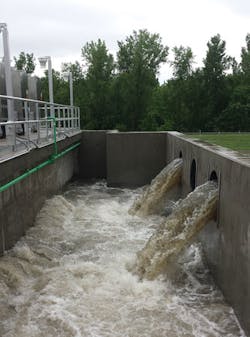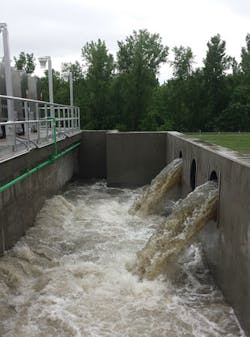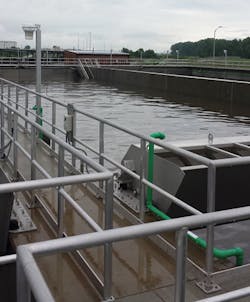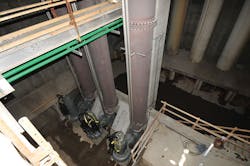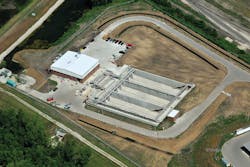Handling Too Much of a Good Thing
By Steve London
Combined sewers, which handle sewage as well as surface runoff, are no longer used in new communities so they do not have to deal with the nightmare of serious water pollution problems during overflow events. In many older cities, however, the problem of wet weather flows exceeding treatment plant capacity continues. Such was the case in Des Moines, Iowa, which traces its roots to 1851.
The Des Moines Metropolitan Wastewater Reclamation Authority (WRA) consists of 17 metro area municipalities, counties, and sewer districts. Working together, they protect public health and enhance the environment by recycling wastewater and being the preferred treatment facilities for hauled liquid wastes. In 2004, the City of Des Moines was retained as the operating contractor to provide operation, maintenance and management services for the WRA.
The WRA includes a conveyance system and a wastewater treatment plant, the Wastewater Reclamation Facility. The conveyance system connects each of the participating communities in Dallas, Polk, and Warren counties to the wastewater treatment facility. The system includes 125 miles of sanitary sewer with pipe sizes up to 144 inches in diameter, equalization basins, and lift stations.
The treatment facility uses a combination of physical, advanced biological, and chemical processes to treat the wastewater as it flows through the plant. During normal flows, these processes produce high-quality reclaimed wastewater that is discharged to the Des Moines River. In addition, biosolids are applied to farm fields for nutrient value and soil amendment, and biogas is utilized for electrical and heat generation. But during large storm events, combined sewer overflow (CSO) would be discharged directly to the Des Moines River - untreated.
Stopping Untreated Discharges
An Iowa Department of Natural Resources and State of Iowa consent order required the WRA to reduce the number, locations, and volumes of CSO flows. In addition, an overriding goal of the WRA’s CSO reduction program was water quality improvement for the Des Moines River and the downtown riverfront area.
In 2008, the WRA retained HDR to provide planning, permitting, design, construction, and start-up services for a high-rate CSO treatment facility called the Combined Sewer Solids Separation Facility or CSSSF. The goal was to store and/or treat CSO flows during wet weather events to meet the water quality goals of the consent order and Long-Term Control Plan. The consultant was asked first to evaluate and select appropriate CSO storage and/or treatment technologies. HDR was then tasked with design and construction phase engineering and observation services for a facility to treat the CSOs. In addition, the facility was to be designed to reduce the adverse impacts of wet weather flows to the existing nearby wastewater reclamation facility. The combined sewer solids separation facility was to consist of a CSO control building, three 60-by-180-foot retention treatment basins, chlorination facilities, a dechlorination building, a twin 72-inch river outfall, and two standby power facilities.
Pumping Design
HDR, working in conjunction with Electric Pump Inc., the local Flygt representative, and with technical assistance from Xylem-Flygt, evaluated several preliminary sump design concepts. The result was an innovative two-stage wet well and sump design concept incorporating a low-flow sump and high-flow pump wet well. The high-flow pump arrangement incorporated new Formed Suction Intakes (FSI) that reduced the size of the wet well. The FSI performance was tested using physical models and then was validated with computational fluid dynamic (CFD) analysis, all to ensure problem-free pump operation while considerably reducing the initial installation cost.
FSI and CFD
The pump manufacturer’s engineers evaluated the original design concept and recommended converting the two side-by-side pump stations into a single sump design concept. This design not only brought both stations together by using standard sump design concepts for the centrifugal pumps and the axial flow pumps but also included FSIs for each of the axial flow pumps to provide an additional reduction in the overall width of the pump station.
A FSI is an inlet device that provides optimal flow conditions to the pumps by gradually accelerating and redirecting the flow toward the pump inlet. A FSI is ideal for use when adverse inflow conditions exist, when space available for the pump station is limited, for intakes with perpendicular or skewed inflows, and for critical installations and continuous operations. CFD analysis is a branch of fluid mechanics that uses numerical analysis and algorithms to solve and analyze problems that involve fluid flows.
HDR’s preliminary design concept included two independent pumping stations: 1) a low-flow pump station to pump smaller flows from more frequent, smaller storm events; and 2) a high-flow pump station to provide the peak flow capacity to prevent upstream overflows during large precipitation events.
Three centrifugal low-flow pumps - Flygt CP-3501, 325-hp submersibles - were sized to provide 90 MGD with all three in service. Submersible and raw water C-pumps operate directly in the liquid being pumped, which means they require neither special housing nor a superstructure to support them, considerably reducing construction costs. They are smaller than non-submersible counterparts because the motor and hydraulics are integrated into one compact unit, resulting in smaller pumping stations that are less complex to build. Operating submerged, they take up less space, and noise and cooling problems are virtually eliminated.
Six Flygt PL-7121, 525-hp axial flow submersible pumps, with a capacity of 300 MGD in the high-flow side of the pump station, were selected to provide the remainder of the 390 MGD of pumping capacity. Submersible PL pumps are compact motor and pump units that require no separate lubrication system or an external cooling system. Quick connection and disconnection for installation and inspection, minimal station superstructure, and simple pipe work are among their other advantages.
Mechanically cleaned bar screens were to be installed in front of the pump station to protect the pumps, and a rock box was designed to be built upstream from the screens to settle out large debris. The design concept would also include two small, submersible centrifugal pumps to allow the wet well to be completely dewatered after an event.
As recommended by Hydraulic Institute standards for the physical or CFD modeling of a pump station of this size, HDR performed a complete CFD analysis to verify the physical modeling already performed on the FSIs by the manufacturer. After completing the analysis, HDR reviewed the results with the manufacturer’s CFD experts to verify that there would be no hydraulic instability at the pump intakes. After a short review process, they concluded that the design was sound.
Realized Benefits
The FSI concept resulted in a smaller channel width while also removing separation walls between adjacent pump tubes, enabling a smaller overall wet well. The unique two-stage wet well provided many advantages: it minimized the wet well footprint, reduced construction costs, and also lowered projected operation and maintenance costs and post-event cleaning efforts. It was determined that the reduced size of the wet well cut the cost of the pump station portion of the project by $1.2 million, or 20 percent.
Treated effluent from the CSSSF is now able to be discharged directly to the Des Moines River. Any wet weather flows from the combined sewer system in excess of the CSSSF and Wastewater Reclamation Facility treatment capacities is screened prior to discharge to the river through the CSSSF, which is located downstream from the Des Moines downtown area.
The CSSSF was put into service on August 31, 2014, to pump CSO flow from two large rain events. The pump station pumped 90 MGD for over three hours and worked as designed with no issue. The CSSSF captured and treated eight million gallons of combined sewer wastewater that would have otherwise been discharged to the Des Moines River untreated. Since that initial storm, the CSSSF has successfully operated during several large storm events, including an extremely large event on June 24, 2015, where over 390 MGD of combined sewer flow were pumped and discharged to the river. This event lasted over six hours with no significant issues.
About the Author: Steve London is president of Steven London Associates (Apollo Beach, Fla.). He has extensive background as a writer and editor specific to municipal water treatment technologies. For the past 19 years, his company has developed application articles that highlight various solutions for water management professionals. London can be contacted at [email protected] or (813) 645-0209.
